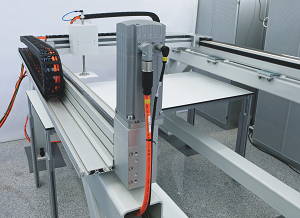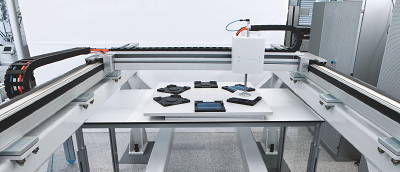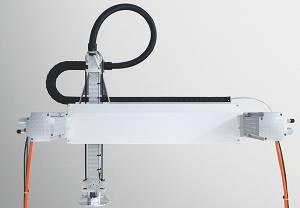High-speed belt-driven gantries `are 30% faster`
Festo has developed a new generation of high-speed H- and T-shaped gantries which, it claims, are 30% faster than conventional handling systems. The gantries combine the dynamics of linear motor systems with the low costs of toothed belt drives. Both types of gantry can carry loads up to 3kg and can reach speeds of 5m/s and acceleration rates of 50m/s² over their entire working areas.

This performance is achieved by using stationary servomotors to drive circulating toothed belts (above). The two belt axes are connected to a cross-member with a single toothed belt rotating around the drive shaft. The two servomotors, mounted parallel to each other, do not need to be moved in the X-Y area, allowing quick, dynamic motion with low wear.

At the Motek materials-handling show in Germany recently, Festo was demonstrating the H-gantry picking and placing solar cells (above). For the Z-axis, it uses a new linear-rotary module consisting of a spindle sleeve with an energy feed-through, and a suction gripper to pick up the cells. This module, which can handle loads up to 2kg, can accelerate at 20m/s2 to reach speeds of 1.5m/s.
The H-gantry has a square-shaped working area that is much larger than those of robot systems with delta kinematics, which can only work in round or kidney-shaped areas. It is also cheaper than the delta robots and needs less space.
The H-gantry can be scaled to any stroke and has a low centre of gravity. It can achieve strokes of 2m and 1m in the X and Y directions, with an accuracy of 0.2 mm.

The T-gantry (above) is a high-speed pick-and-place system with higher dynamics than conventional linear gantries. It can achieve 1m strokes in both the X and Y directions, and 300mm in the Z direction, with a positioning accuracy of 0.2 mm.
The gantries are controlled using Festo’s CMXR robot controller which can combine mechanical systems with electric drives and controls technologies in a kinematic system which co-ordinates dynamic motion in 3D space. The controller interpolates and positions all axes and can set path switching points.
The CMXR acts as an interface between master controllers and servo-axis motor controllers and valve terminals. It can also integrate image-processing systems, allowing moving objects to be guided by a camera system.





